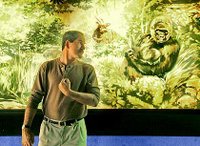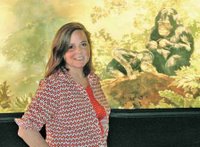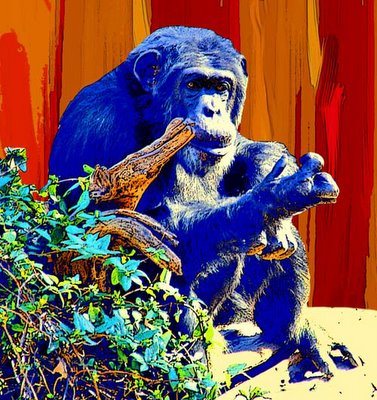
The internet "intellectual site"
Edge has recently published the answers to its
Question of the Year. The question this year was "
What is Your Dangerous Idea?" The answers came from a range of intellectuals, 117 of them to be precise. Most of them are physicists or psychologists, many scientists from other areas, a few writers. And three (non-writer) artists. Make that four - I forgot Michael "Nez" Lesmith, ex-member of The Monkees, who writes that according to him "Existence is Non-Time, Non-Sequential, and Non-Objective". (I'm glad - and somewhat scared - to know that.) As for the other three artists... The first one to appear is Richard Foreman, declaring that "
Radicalized relativity" is his dangerous idea:
In my area of the arts and humanities, the most dangerous idea (and the one under who's influence I have operated throughout my artistic life) is the complete relativity of all positions and styles of procedure. The notion that there are no "absolutes" in art — and in the modern era, each valuable effort has been, in one way or another, the highlighting and glorification of elements previous [I think it should be "previously" - Vvoi] "off limits" and rejected by the previous "classical" style.
This rhetoric is so old I think it isn't really worth spending too much time on its critique (I've been writing about the issues and problems of the avant garde quite often anyway). Suffice it to say we all know there are no "absolutes", until we build them. And Foreman's theater has built such an absolute out of a particular stage language, a very consistent and not at all "off limits" one, at least not if by the term one means something innovative.
The second artist to answer the question is "famous landscape painter"
April Gornik. And she makes an interesting remark:
The exact effect of art can't be controlled or fully anticipated
Great art makes itself vulnerable to interpretation, which is one reason that it keeps being stimulating and fascinating for generations. The problem inherent in this is that art could inspire malevolent behavior, as per the notion popularly expressed by A Clockwork Orange. When I was young, aspiring to be a conceptual artist, it disturbed me greatly that I couldn't control the interpretation of my work. When I began painting, it was even worse; even I wasn't completely sure of what my art meant. That seemed dangerous for me, personally, at that time. I gradually came not only to respect the complexity and inscrutability of painting and art, but to see how it empowers the object. I believe that works of art are animated by their creators, and remain able to generate thoughts, feelings, responses. However, the fact is that the exact effect of art can't be controlled or fully anticipated.
This is indeed interesting, and every artist must have had this experience - the work lives its own life. It isn't quite what I would call a revolutionary insight, but it is probably something new to many amateurs (and amateur amateurs) of art.
Finally, we have one of the "art starlets of the 90's",
Eric Fischl. I do not particularly appreciate his work, but here is a thought of his that might sound intriguing:
(...) Vermeer puts me into what had been [his subject's] condition of uncertainty. All I can do is wonder and wait. This makes me think about how not knowing is so important. Not knowing makes the world large and uncertain and our survival tenuous. It is a mystery why humans roam and still more a mystery why we still need to feel so connected to the place we have left. The not knowing causes such profound anxiety it, in turn, spawns creativity. The impetus for this creativity is empowerment. Our gadgets, gizmoes, networks of transportation and communication, have all been developed either to explore, utilize or master the unknown territory.
If the unknown becomes known, and is not replaced with a new unknown, if the farther we reach outward is connected only to how fast we can bring it home, if the time between not knowing and knowing becomes too small, creativity will be daunted. And so I worry, if we bring the universe more completely, more effortlessly, into our homes will there be less reason to leave them?
What should I make of this? If you happen to have no background in philosophy, you might be impressed. The problem is, right next to this answer are more than a hundred answers that prove it wrong. They are ideas and reflections that put us back into a state of uncertainty, which, it is true, "spawns creativity", demanding new answers, new questions, new ways of touching.
Maybe, just maybe, the artists are supposed to be the ones touching, and not reflecting. And that would be the reason for such (I'm sorry) lame answers. My point is not that artists are stupid though. That they express, but are bad at analyzing. Many proofs have been giving of how false this statement is. Rather, I wonder - weren't the artists supposed to be the ones with dangerous ideas? The revolutionaries? The inventors of new worlds?
Here's an idea: they still might be. But nobody really cares, because artists live in a parallel world. Even the intellectual elites have no idea who can be an (intellectual, not just "intuitive" !) challenge for them. Who can be a partner in a crazy conversation about the future.
The good news is, no Hollywood stars even got a chance to answer the question. The bad - if the artists keep on answering so badly, or so quietly, they're bound to disappear, too. Without the comforting entertainment-style check...

pictures by April Gornik - Field and Storm (2003) and Storm at Sea (2005)





